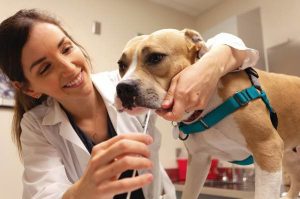
Dr. Anna Costa uses a cheek swab to collect DNA from a dog at the Washington State University Veterinary Teaching Hospital in Pullman.
Researcher discusses new insights into the canine genome and how it informs research on human health
By Scott Jackson, Daily News staff writer
Geneticist Elaine Ostrander is bringing the world closer to understanding hereditary diseases in humans by studying their canine companions.
Chief of the Cancer Genetics branch of the Human Genome Research Institute, Ostrander spoke at an event hosted by Washington State University in a talk titled “How to Build a Dog in 2,392,715,236 Steps,” in reference to the number of base pairs in the canine genome.
Ostrander said her lab collects and stores DNA from all 450 internationally recognized dog breeds as well as some mixed breeds. She said this translates into DNA from 30,000 individual dogs.
She said there are multiple reasons studying the dog genome is helpful in
understanding human health. For one thing, she said, while all 450 domestic dog breeds are the same species – canis familiaris – they exhibit extraordinary diversity in physiological and behavioral traits.
There is also a good deal of disease susceptibility due to selective breeding practices.
Moreover, she said dogs get all the same diseases that people do, and one of the easiest ways to map genetic traits in humans is by looking at variability in isolated groups like Bedouin or Icelandic populations.
“The problem in human genetics is we only have a few dozen such isolated populations, but in dog breeds, we have literally 450,” Ostrander said. “They offer us a chance to isolate the genes behind interesting traits, interesting diseases and behaviors that would really be virtually impossible to try and tackle if we were just restricted to using human families and human populations.”
Ostrander said her team put together a database representative of 161 different dog species. Using this data set, she said researchers can trace which genetic mutations may be responsible for specific traits – whether it be disease or a more simple trait, like the degree of droop to a dog’s ears.
She said through tracing mutational similarities, scientists can further conclude which breeds were brought together to form new breeds and how long ago these breeds shared a common ancestor.
She points out most modern dog breeds only go back to the Victorian era, and dogs themselves have only been domesticated for around 15,000 to 30,000 years.
“We now have a lot of information – we know which breeds are related one to another, we know how they were formed and we also know when they were formed,” Ostrander said. “Now I actually have a lot of power for trying to find genes that are behind interesting traits that I care about.”
Ostrander used studies related to bladder cancer as an example. She said bladder cancer in dogs and humans have a striking number of similarities – both occur spontaneously, have a similar age of onset, similar symptoms, drug response, pathology and location of the tumor.
She said researchers immediately found 85 percent of these tumors in dogs share the same genetic mutation.
“What was so interesting was that this particular mutation … is very frequently found in human tumors – not bladder tumors, but in human colon tumors and in human melanoma tumors,” Ostrander said. “Whether you’re a human or a dog, if you have this mutation, it’s associated with a poor outcome.”
Moving forward, Ostrander said her lab is still studying how these mutations within tumors affect the genome of tumor cells and what causes the mutation in the first place.
“We’re in the process now of sequencing lots and lots of tumors in lots of affected dogs and also unaffected dogs,” Ostrander said. “I truly don’t know what the underlying mutations are at this point but, clearly, this is going to be a really good system from which we’ll learn more about human transitional cell carcinoma of the bladder.”








